Top Rankings
Bayonne School District ranks among the top 20% of public school district in New Jersey for:
Category
Attribute
Diversity
Most diverse schools (Top 1%)
Community Size
Largest student body (number of students) (Top 1%)
For the 2025 school year, there are 11 public preschools serving 7,273 students in Bayonne School District. This district's average pre testing ranking is 3/10, which is in the bottom 50% of public pre schools in New Jersey.
Public Preschools in Bayonne School District have an average math proficiency score of 28% (versus the New Jersey public pre school average of 34%), and reading proficiency score of 46% (versus the 44% statewide average).
Minority enrollment is 56% of the student body (majority Hispanic), which is less than the New Jersey public preschool average of 64% (majority Hispanic).
Overview
This School District
This State (NJ)
# Schools
13 Schools
924 Schools
# Students
10,271 Students
368,931 Students
# Teachers
831 Teachers
33,283 Teachers
Student : Teacher Ratio
12:1
12:1
District Rank
Bayonne School District, which is ranked within the bottom 50% of all 646 school districts in New Jersey (based off of combined math and reading proficiency testing data) for the 2021-2022 school year.
The school district's graduation rate of 86% has stayed relatively flat over five school years.
Overall District Rank
#422 out of 650 school districts
(Bottom 50%)
(Bottom 50%)

Math Test Scores (% Proficient)
27%
36%

Reading/Language Arts Test Scores (% Proficient)
45%
49%
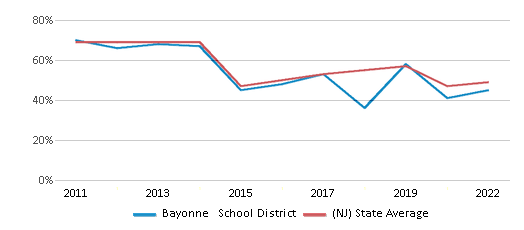
Science Test Scores (% Proficient)
13%
23%
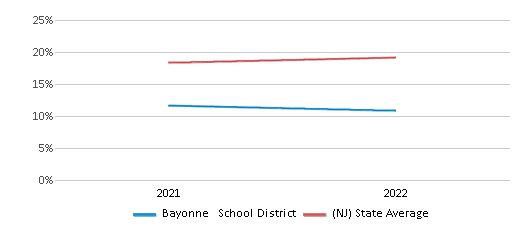
Graduation Rate
86%
85%
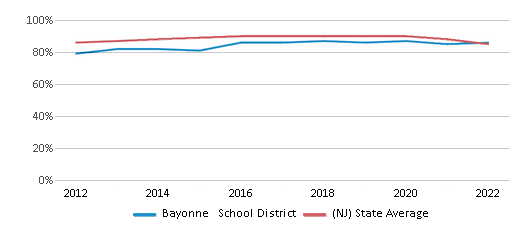
Students by Ethnicity:
Diversity Score
0.71
0.71
# American Indian Students
60 Students
901 Students
% American Indian Students
1%
n/a
# Asian Students
807 Students
30,033 Students
% Asian Students
8%
8%
# Hispanic Students
3,019 Students
132,928 Students
% Hispanic Students
29%
36%
# Black Students
1,606 Students
58,834 Students
% Black Students
16%
16%
# White Students
4,328 Students
132,766 Students
% White Students
42%
36%
# Hawaiian Students
38 Students
790 Students
% Hawaiian Students
n/a
n/a
# Two or more races Students
407 Students
12,631 Students
% of Two or more races Students
4%
4%
Students by Grade:
# Students in PK Grade:
626
59,693
# Students in K Grade:
696
56,070
# Students in 1st Grade:
735
51,032
# Students in 2nd Grade:
730
50,036
# Students in 3rd Grade:
720
42,983
# Students in 4th Grade:
724
37,934
# Students in 5th Grade:
777
29,352
# Students in 6th Grade:
773
15,586
# Students in 7th Grade:
764
11,676
# Students in 8th Grade:
728
11,589
# Students in 9th Grade:
855
663
# Students in 10th Grade:
752
626
# Students in 11th Grade:
706
579
# Students in 12th Grade:
685
1,080
# Ungraded Students:
-
32
District Revenue and Spending
The revenue/student of $19,841 in this school district is less than the state median of $26,931. The school district revenue/student has stayed relatively flat over four school years.
The school district's spending/student of $19,071 is less than the state median of $25,828. The school district spending/student has stayed relatively flat over four school years.
Total Revenue
$204 MM
$36,642 MM
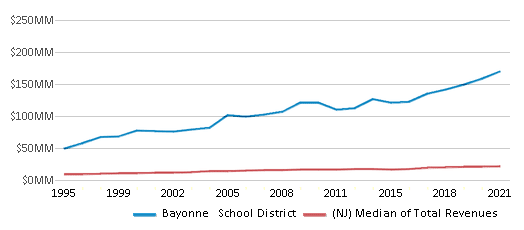
Spending
$196 MM
$35,142 MM
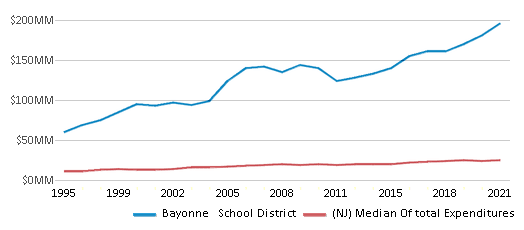
Revenue / Student
$19,841
$26,931
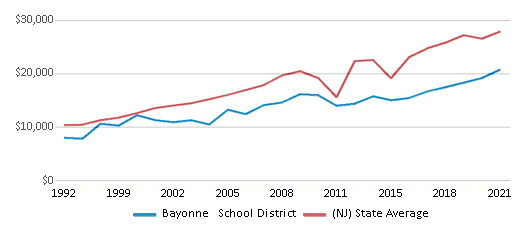
Spending / Student
$19,071
$25,828
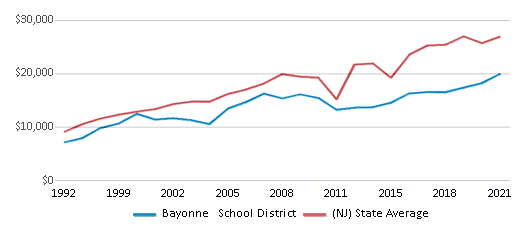
Best Bayonne School District Public Preschools (2025)
School
(Math and Reading Proficiency)
(Math and Reading Proficiency)
Location
Grades
Students
Rank: #11.
Nicholas Oresko Community School
(Math: 62% | Reading: 75%)
Rank:
Rank:
9/
Top 20%10
33 East 24th Street
Bayonne, NJ 07002
(201) 858-6281
Bayonne, NJ 07002
(201) 858-6281
Grades: PK-8
| 384 students
Rank: #22.
Philip G. Vroom Community School
(Math: 34% | Reading: 49%)
Rank:
Rank:
5/
Bottom 50%10
18 West 26th St
Bayonne, NJ 07002
(201) 858-5956
Bayonne, NJ 07002
(201) 858-5956
Grades: PK-8
| 437 students
Rank: #33.
John M. Bailey Community School
(Math: 28% | Reading: 51%)
Rank:
Rank:
5/
Bottom 50%10
75 West 10th Street
Bayonne, NJ 07002
(201) 858-5824
Bayonne, NJ 07002
(201) 858-5824
Grades: PK-8
| 632 students
Rank: #44.
Walter F. Robinson Community School
(Math: 32% | Reading: 45%)
Rank:
Rank:
5/
Bottom 50%10
95 West 31st Street
Bayonne, NJ 07002
(201) 858-5964
Bayonne, NJ 07002
(201) 858-5964
Grades: PK-8
| 885 students
Rank: #55.
Lincoln Community School #5
(Math: 28% | Reading: 46%)
Rank:
Rank:
4/
Bottom 50%10
208 Prospect Avenue
Bayonne, NJ 07002
(201) 858-5973
Bayonne, NJ 07002
(201) 858-5973
Grades: PK-8
| 485 students
Rank: #66.
Mary J Donohoe Community School
(Math: 24% | Reading: 47%)
Rank:
Rank:
4/
Bottom 50%10
25 East 5th Street
Bayonne, NJ 07002
(201) 858-5969
Bayonne, NJ 07002
(201) 858-5969
Grades: PK-8
| 492 students
Rank: #77.
Washington Community School #9
(Math: 27% | Reading: 42%)
Rank:
Rank:
4/
Bottom 50%10
191 Avenue B
Bayonne, NJ 07002
(201) 858-5990
Bayonne, NJ 07002
(201) 858-5990
Grades: PK-8
| 678 students
Rank: #88.
Woodrow Wilson Community School
(Math: 23% | Reading: 44%)
Rank:
Rank:
4/
Bottom 50%10
101 West 56th Street
Bayonne, NJ 07002
(201) 858-5996
Bayonne, NJ 07002
(201) 858-5996
Grades: PK-8
| 721 students
Rank: #99.
William Shemin Midtown Community School #8
(Math: 26% | Reading: 38%)
Rank:
Rank:
4/
Bottom 50%10
550 Avenue A
Bayonne, NJ 07002
(201) 858-5984
Bayonne, NJ 07002
(201) 858-5984
Grades: PK-8
| 1,235 students
Rank: #1010.
Henry E. Harris Community School
(Math: 19% | Reading: 41%)
Rank:
Rank:
3/
Bottom 50%10
135 Avenue C
Bayonne, NJ 07002
(201) 858-5945
Bayonne, NJ 07002
(201) 858-5945
Grades: PK-8
| 646 students
Rank: #1111.
Horace Mann Community School
(Math: 20% | Reading: 38%)
Rank:
Rank:
3/
Bottom 50%10
25 West 38th Street
Bayonne, NJ 07002
(201) 858-5979
Bayonne, NJ 07002
(201) 858-5979
Grades: PK-8
| 678 students
Recent Articles

Year-Round Or Traditional Schedule?
Which is more appropriate for your child? A year-round attendance schedule or traditional schedule? We look at the pros and cons.

Why You Should Encourage Your Child to Join a Sports Team
Participating in team sports has a great many benefits for children, there is no doubt. In this article you will learn what those benefits are.

White Students are Now the Minority in U.S. Public Schools
Increasing birth rates among immigrant families from Asia and Central and South America, combined with lower birth rates among white families, means that for the first time in history, public school students in the United States are majority-minority. This shift in demographics poses difficulties for schools as they work to accommodate children of varying language abilities and socio-economic backgrounds.





